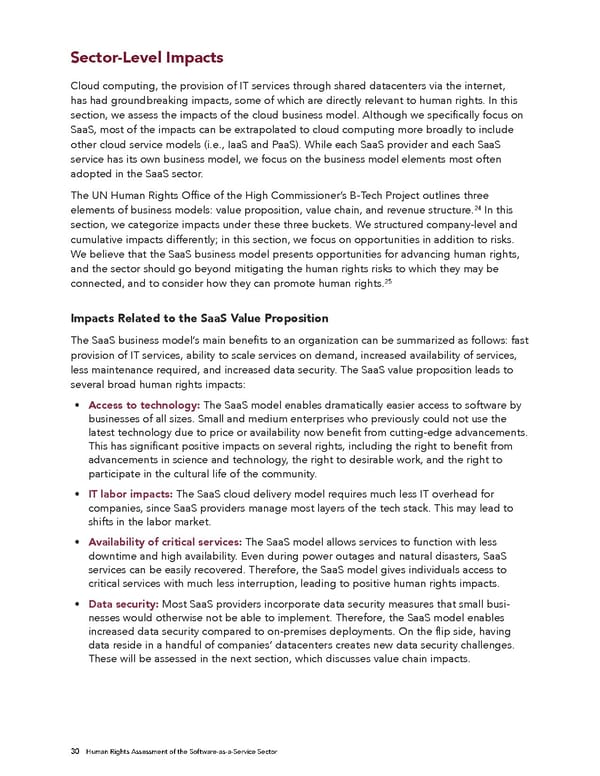Sector-Level Impacts Cloud computing, the provision of IT services through shared datacenters via the internet, has had groundbreaking impacts, some of which are directly relevant to human rights. In this section, we assess the impacts of the cloud business model. Although we specifically focus on SaaS, most of the impacts can be extrapolated to cloud computing more broadly to include other cloud service models (i.e., IaaS and PaaS). While each SaaS provider and each SaaS service has its own business model, we focus on the business model elements most often adopted in the SaaS sector. The UN Human Rights Office of the High Commissioner’s B-Tech Project outlines three 24 elements of business models: value proposition, value chain, and revenue structure. In this section, we categorize impacts under these three buckets. We structured company-level and cumulative impacts differently; in this section, we focus on opportunities in addition to risks. We believe that the SaaS business model presents opportunities for advancing human rights, and the sector should go beyond mitigating the human rights risks to which they may be 25 connected, and to consider how they can promote human rights. Impacts Related to the SaaS Value Proposition The SaaS business model’s main benefits to an organization can be summarized as follows: fast provision of IT services, ability to scale services on demand, increased availability of services, less maintenance required, and increased data security. The SaaS value proposition leads to several broad human rights impacts: • Access to technology: The SaaS model enables dramatically easier access to software by businesses of all sizes. Small and medium enterprises who previously could not use the latest technology due to price or availability now benefit from cutting-edge advancements. This has significant positive impacts on several rights, including the right to benefit from advancements in science and technology, the right to desirable work, and the right to participate in the cultural life of the community. • IT labor impacts: The SaaS cloud delivery model requires much less IT overhead for companies, since SaaS providers manage most layers of the tech stack. This may lead to shifts in the labor market. • Availability of critical services: The SaaS model allows services to function with less downtime and high availability. Even during power outages and natural disasters, SaaS services can be easily recovered. Therefore, the SaaS model gives individuals access to critical services with much less interruption, leading to positive human rights impacts. • Data security: Most SaaS providers incorporate data security measures that small busi- nesses would otherwise not be able to implement. Therefore, the SaaS model enables increased data security compared to on-premises deployments. On the flip side, having data reside in a handful of companies’ datacenters creates new data security challenges. These will be assessed in the next section, which discusses value chain impacts. 30 Human Rights Assessment of the Software-as-a-Service Sector
 Human Rights Assessment of the Software-as-a-Service Sector Page 30 Page 32
Human Rights Assessment of the Software-as-a-Service Sector Page 30 Page 32